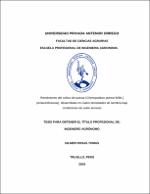Rendimiento del cultivo de quinua (Chenopodium quinoa Willd.) (Amaranthaceae), desarrollado en cuatro densidades de siembra bajo condiciones de suelo arenoso

View/
Download
(application/pdf: 1.339Mb)
(application/pdf: 1.339Mb)
Date
2019Author(s)
Rosas Tomás, Gilmer
Metadata
Show full item recordAbstract
El presente trabajo de investigación titulado: Rendimiento del cultivo de quinua
(Chenopodium quinoa Willd.) (Amaranthaceae), desarrollado en cuatro
densidades de siembra bajo condiciones de suelo arenoso, y con el cultivar
Salcedo INIA tuvo como objetivo contribuir al entendimiento sobre los efectos
de la densidad poblacional, siendo de 300, 400, 500 y 600 mil plantas ha־¹
evaluando el rendimiento de kg. ha־¹ y otros parámetros relacionados. El
diseño estadístico fue de bloques completos al azar (DBCA), la valoración
estadística es en base al análisis de varianza (ANOVA) y la prueba de Duncan
al 0.05% de significación. Basándonos en los resultados obtenidos, la altura
de plantas y número de panojas se asocian negativamente con el aumento de
densidad; el tamaño de panojas y diámetro de tallo muestran una correlación
positiva al disminuir la densidad mostrando estos parámetros diferencias
significativas; el tamaño de grano y peso de 1000 granos no mostraron
diferencias significativas. La posible explicación para estos dos parámetros es
que predominan las características genéticas. En cuanto al rendimiento de kg
ha־¹ sí hubo diferencias significativas, donde los mejores resultados se
obtuvieron con densidades entre 400 y 500 mil plantas ha־¹. La posible
explicación para estos resultados con el cultivar salcedo INIA y bajo
condiciones de suelo arenoso es que, en el cultivo de quinua sí hay
competencia de agua, luz y nutrientes; donde a mayor densidad hay una
respuesta negativa del rendimiento, y por el contrario a menor densidad no
hay suficiente producción de granos para llegar a máximo rendimiento de kg
ha־¹. The present work of investigation titled: Yield of the cultivation of quinoa
(Chenopodium quinoa Willd.) (Amaranthaceae), developed in four densities of
sowing under sandy soil conditions“, and with the cultivar Salcedo INIA had as
objective to contribute to the understanding on the effects of the population
density, being of 300, 400, 500 and 600 thousand plants ha -¹ evaluating the
yield of kg ha -¹ and other related parameters. The statistical design was
randomized complete blocks (DBCA), the statistical evaluation is based on the
analysis of variance (ANOVA) and the Duncan test at 0.05% significance.
Based on the results obtained, plant height and number of panicles are
negatively associated with the increase in density; the size of panicles and
stem diameter show a positive correlation when decreasing density, these
parameters showing significant differences; the grain size and weight of 1000
grains showed no significant differences. The possible explanation for these
two parameters is that genetic characteristics predominate. Regarding the yield
of kg ha -¹ there were significant differences, where the best results were
obtained with densities between 400 and 500 thousand plants ha -¹. The
possible explanation for these results with the cultivar Salcedo INIA and under
sandy soil conditions is that, in the cultivation of quinoa there is competition for
water, light and nutrients; where at higher density there is a negative yield
response, and conversely at lower density there is not enough grain production
to reach maximum yield of kg ha -¹.
Collections
- Ingeniería Agrónoma [99]

